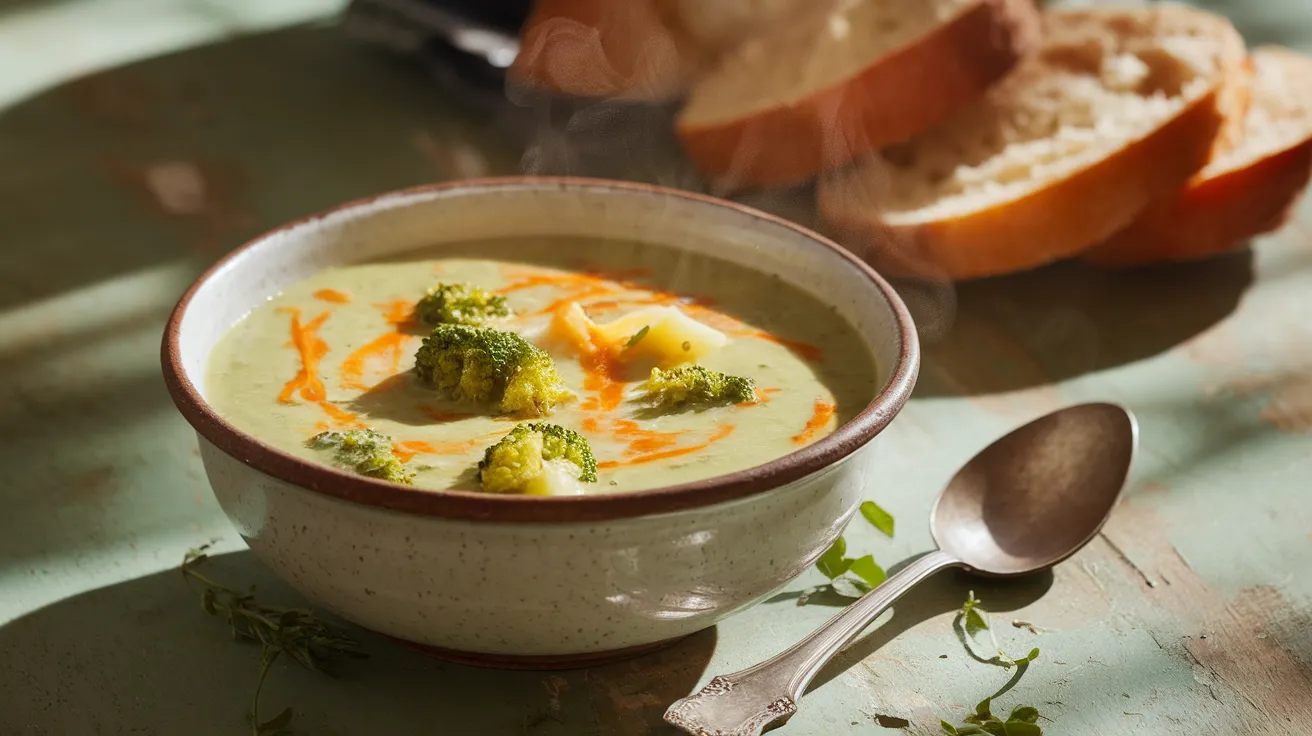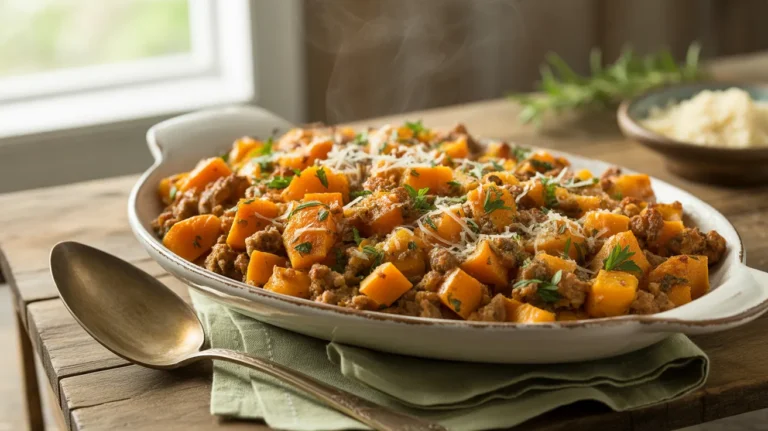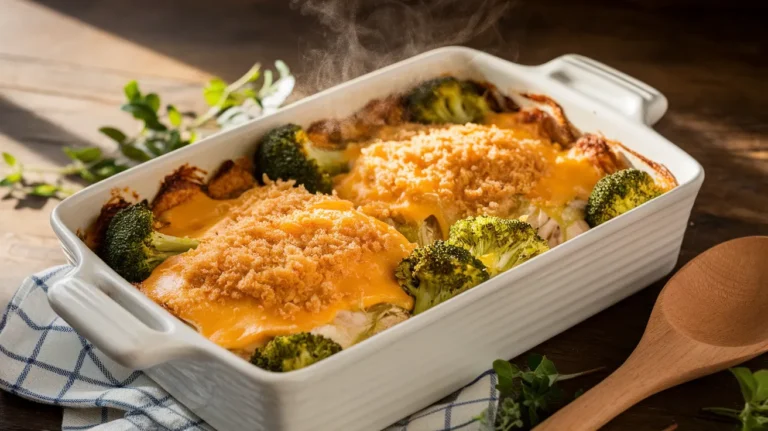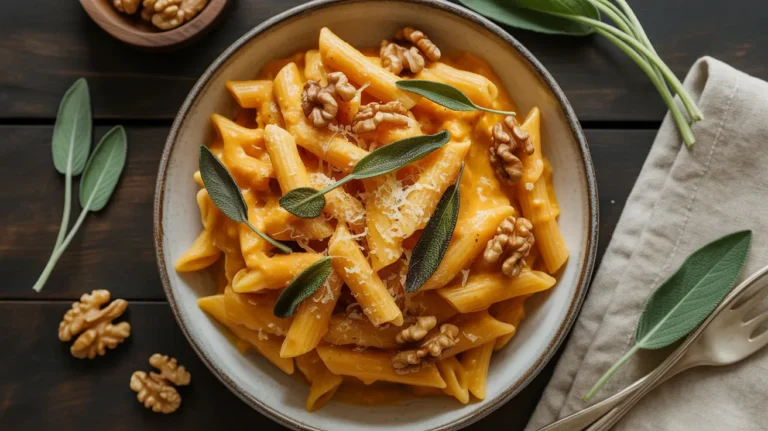This hearty broccoli potato soup combines tender vegetables in a rich, creamy base that’s perfect for chilly evenings. Our broccoli potato soup recipe delivers restaurant-quality flavor using simple ingredients you likely have on hand. Ready in just 45 minutes, this comforting bowl serves four hungry people with plenty of satisfying nutrition.
SERVES: 4 | PREP: 15 MIN | COOK: 30 MIN | TOTAL: 45 MIN
Ingredients
Fresh Vegetables
| Ingredient | Amount |
|---|---|
| Fresh broccoli heads | 2 large (about 2 lbs) |
| Yukon Gold potatoes | 3 medium (1.5 lbs) |
| Yellow onion | 1 medium |
| Garlic cloves | 3 large |
| Fresh carrots | 2 medium |
Pantry Essentials
| Ingredient | Amount |
|---|---|
| Vegetable broth | 4 cups |
| Heavy cream | 1 cup |
| Unsalted butter | 3 tablespoons |
| All-purpose flour | 2 tablespoons |
| Sharp cheddar cheese | 1 cup shredded |
| Salt | 1 teaspoon |
| Black pepper | 1/2 teaspoon |
| Dried thyme | 1/2 teaspoon |
Step-by-Step Instructions
Preparation Phase (10 minutes)
Step 1: Wash and chop your broccoli into bite-sized florets, keeping stems separate. Don’t throw away those stems – they add fantastic flavor and nutrition to your broccoli potato soup. Peel stems and dice them into small pieces.
Step 2: Scrub potatoes thoroughly under cold water. Peel if desired (keeping skins adds fiber and nutrients). Cut into uniform 1-inch cubes so they cook evenly. Uneven pieces mean some will be mushy while others stay hard.
Step 3: Dice your onion finely – aim for pieces about 1/4-inch. Smaller pieces will dissolve into the soup base, creating better flavor distribution. Mince garlic cloves and set aside separately since garlic burns faster than onions.
Step 4: Peel carrots and slice into thin rounds. These add natural sweetness and beautiful color flecks to your finished soup.
Building the Base (8 minutes)
Step 5: Heat butter in a large, heavy-bottomed pot over medium heat. The pot should be big enough to hold all ingredients comfortably. Heavy-bottomed pots prevent scorching and ensure even heating.
Step 6: Add diced onions and cook for 3-4 minutes until they start turning translucent. You’ll hear gentle sizzling – if it’s aggressive, lower the heat. Burnt onions create bitter flavors that can’t be fixed.
Step 7: Stir in minced garlic and cook for 30 seconds until fragrant. Garlic should smell amazing but not brown. If it browns, it becomes bitter and overpowers the delicate broccoli flavor.
Step 8: Sprinkle flour over the vegetables and stir constantly for 2 minutes. This creates a roux that will thicken your broccoli potato soup naturally. The flour should coat all vegetables and smell slightly toasted.
Cooking Phase (15 minutes)
Step 9: Gradually pour in vegetable broth while stirring continuously. Add it slowly to prevent lumps from forming. The mixture will look cloudy at first but will smooth out as it heats.
Step 10: Add cubed potatoes and diced broccoli stems to the pot. These harder vegetables need more cooking time than florets. Bring mixture to a gentle boil, then reduce to a simmer.
Step 11: Cover and simmer for 10 minutes until potatoes are fork-tender. Test by poking the largest piece – it should offer no resistance. Undercooked potatoes will remain grainy in your finished soup.
Step 12: Add broccoli florets and sliced carrots. These cook quickly, so timing matters. Overcooking turns broccoli gray and mushy, which affects both appearance and nutrition.
Final Assembly (7 minutes)
Step 13: Simmer uncovered for 5 minutes until broccoli is bright green and tender-crisp. It should still have some bite – mushy broccoli indicates overcooking.
Step 14: Reduce heat to low. Slowly stir in heavy cream, adding it gradually to prevent curdling. If your soup is too hot, the cream might separate and create an unappetizing texture.
Step 15: Add salt, pepper, and thyme. Taste and adjust seasoning – the soup should taste bright and well-balanced. Remember that cheese will add saltiness in the next step.
Step 16: Remove from heat and stir in half the shredded cheese until melted and smooth. The residual heat will melt the cheese perfectly without making it stringy or grainy.
Chef’s Notes
Texture Control: For a partially smooth broccoli potato soup, use an immersion blender to puree about half the soup, leaving chunky vegetables for texture contrast.
Cheese Selection: Sharp cheddar provides the best flavor, but Gruyere or white cheddar work beautifully too. Pre-shredded cheese contains anti-caking agents that can affect melting.
Broth Boost: Roast your broccoli stems separately for 15 minutes before adding to develop deeper, more complex flavors in your final dish.
Make-Ahead Magic: This broccoli potato soup tastes even better the next day as flavors meld. Cool completely before refrigerating to maintain food safety.
Nutrition Per Serving
Calories: 340 | Protein: 12g | Carbs: 28g | Fat: 22g | Fiber: 6g | Sodium: 780mg
Creative Variations
Loaded Broccoli Potato Soup: Top with crispy bacon bits, extra cheese, and green onions for a restaurant-style presentation that rivals any steakhouse version.
Lighter Version: Substitute half-and-half for heavy cream and reduce cheese to 1/2 cup. You’ll save calories without sacrificing the creamy texture that makes this soup special.
Spicy Twist: Add 1/4 teaspoon cayenne pepper and a dash of hot sauce. The heat complements broccoli’s earthiness beautifully, similar to how spices enhance this broccoli yogurt salad.
Protein Power: Stir in diced rotisserie chicken during the last 5 minutes for a complete meal that’s even more satisfying than traditional broccoli leek soup.
Storage & Reheating
Refrigeration: Store leftover broccoli potato soup in covered containers for up to 4 days. The flavors actually improve as they meld together overnight.
Freezing: Freeze for up to 3 months, but note that cream-based soups may separate slightly when thawed. Stir vigorously while reheating to recombine.
Reheating: Warm gently over low heat, stirring frequently. Add splash of broth if soup becomes too thick. Avoid rapid boiling which can cause cream to curdle.
Portion Control: Freeze in individual containers for quick weeknight dinners. Thaw overnight in refrigerator for best results.
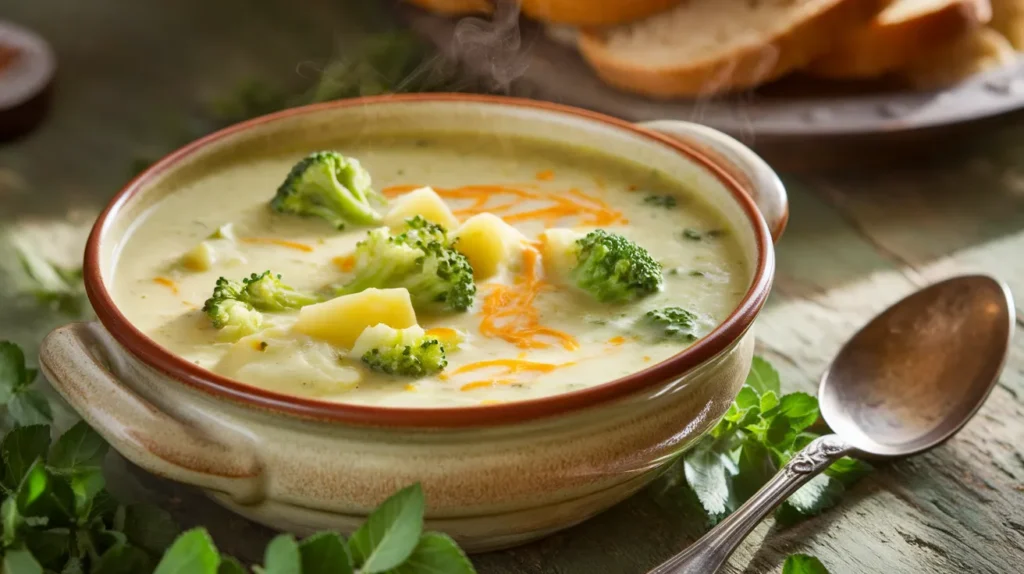
Troubleshooting Guide
Problem: Soup is too thin Solution: Mix 2 tablespoons cornstarch with cold water to create a slurry. Stir into simmering soup until desired thickness is reached.
Problem: Cream curdled when added Solution: Remove from heat immediately. Blend with immersion blender to smooth out texture. Prevention: always add cream to cooled soup.
Problem: Vegetables are mushy Solution: This happens from overcooking. Next time, add broccoli florets later in cooking process. Mushy vegetables can’t be fixed but soup still tastes good.
Problem: Soup tastes bland Solution: Add more salt gradually, then try lemon juice to brighten flavors. Sometimes soup needs acid to make other flavors pop.
Problem: Soup is too salty Solution: Add diced raw potatoes and simmer 15 minutes – they’ll absorb excess salt. Remove potato pieces before serving.
Equipment Essentials
- Large heavy-bottomed pot (prevents burning and ensures even heating)
- Sharp chef’s knife (for efficient vegetable prep)
- Cutting board (preferably wood or plastic for vegetables)
- Immersion blender (optional, for texture control)
- Ladle (for easy serving)
- Measuring cups and spoons (for accurate ingredient ratios)
Shopping List
Produce Section
- 2 large fresh broccoli heads
- 3 medium Yukon Gold potatoes
- 1 medium yellow onion
- 1 head fresh garlic
- 2 medium carrots
Dairy Section
- 1 cup heavy cream
- 3 tablespoons unsalted butter
- 1 cup sharp cheddar cheese
Pantry/Dry Goods
- 32 oz vegetable broth
- All-purpose flour
- Salt and black pepper
- Dried thyme
Success Secrets
- Cut vegetables uniformly – This ensures everything cooks at the same rate, preventing some pieces from being overcooked while others remain raw.
- Don’t skip the roux step – Cooking flour with vegetables creates natural thickening that’s more stable than adding cream alone.
- Add cream off the heat – This prevents curdling and maintains the silky texture that makes broccoli potato soup so appealing.
- Taste and adjust seasoning – Soup flavors concentrate as they cook, so always taste before serving and adjust salt and pepper accordingly.
- Save some cheese for garnish – Sprinkling fresh cheese on top adds visual appeal and gives diners an extra flavor burst in every spoonful.
